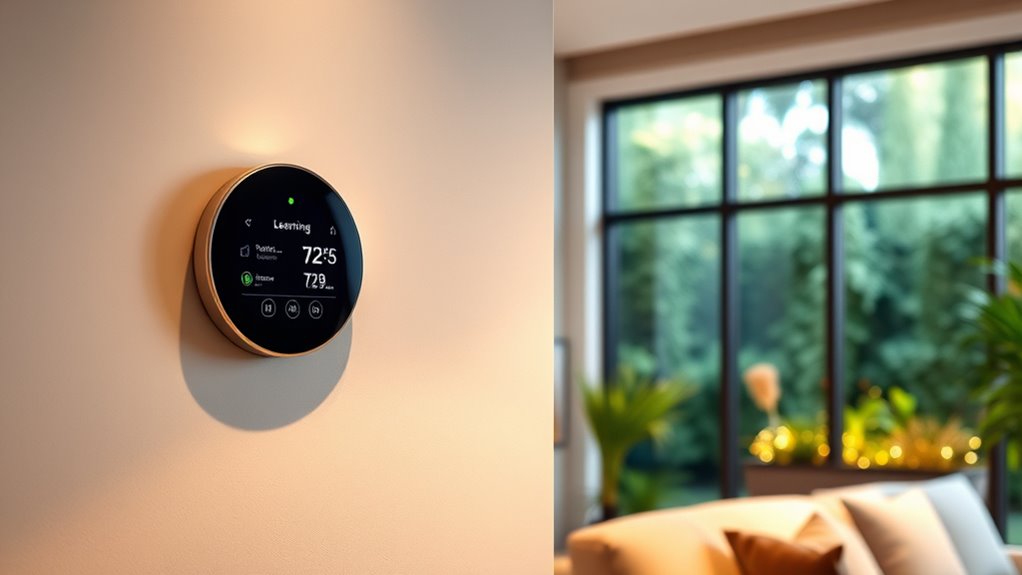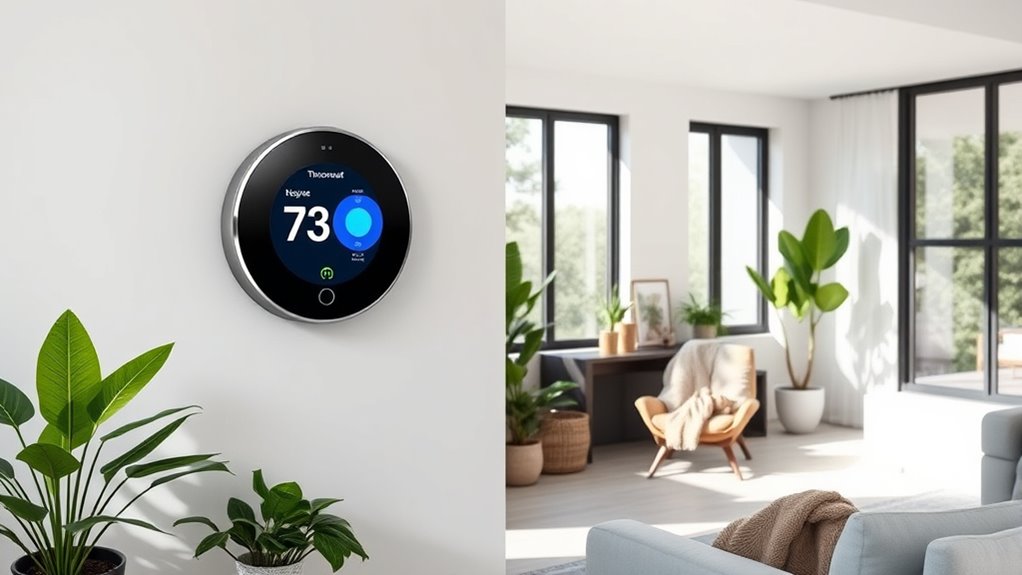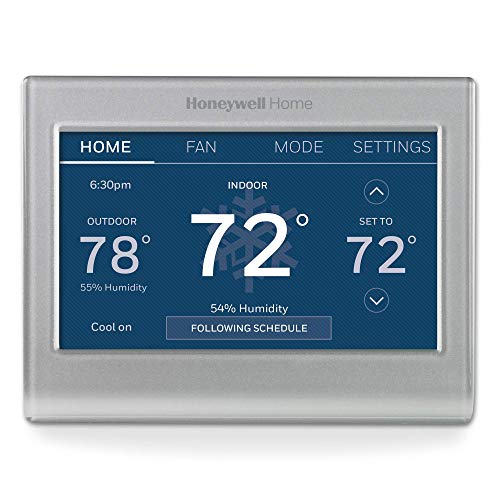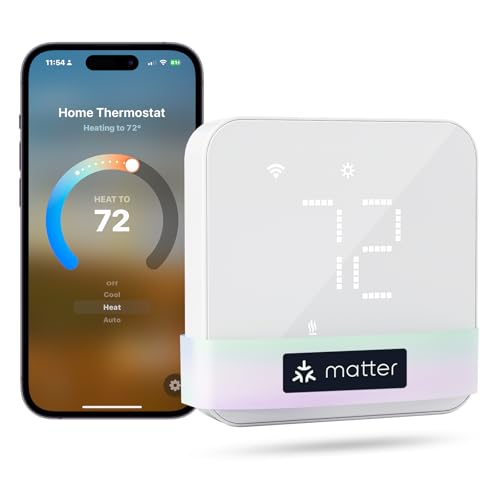I’ve found that the best smart thermostats with learning features can really help save energy and money by automatically adjusting your home’s temperature based on your routines. Models like the Nest Learning Thermostat and ecobee Smart Thermostat adapt to your habits and work with popular smart home systems. They’re easy to install and offer remote control through apps. If you want to discover more top options and tips, keep exploring what’s available.
Key Takeaways
- Many top smart thermostats, like Nest Learning Thermostat and ecobee SmartThermostat, automatically learn your schedule to optimize energy use.
- These thermostats can significantly reduce heating and cooling costs through adaptive scheduling and energy-saving features.
- Compatibility with various HVAC systems and smart home ecosystems ensures seamless integration and remote control capabilities.
- Features like geofencing, auto-scheduling, and system monitoring help maximize energy savings and prevent costly maintenance.
- ENERGY STAR-certified models offer efficient operation, providing both cost savings and environmental benefits.
Google Nest Thermostat, Programmable Wi-Fi Smart Thermostat
If you’re looking for a smart thermostat that combines energy savings with easy remote control, the Google Nest Thermostat is an excellent choice. It’s ENERGY STAR certified and supports both 2.4 GHz and 5 GHz Wi-Fi, making setup simple and flexible. You can control it anytime through the Google Home app on your Android or iPhone, whether you’re at home or away. It adapts to your schedule with programmable routines and suggests tweaks for maximum savings. Plus, it monitors your HVAC system, sending alerts if issues occur. With its sleek design and smart features, it helps you stay comfortable while reducing energy costs effortlessly.
Best For: homeowners seeking an ENERGY STAR certified, Wi-Fi-enabled smart thermostat that offers remote control and energy-saving features.
Pros:
- Supports both 2.4 GHz and 5 GHz Wi-Fi networks for flexible setup
- Allows remote temperature control via the Google Home app on smartphones and tablets
- Monitors HVAC system health and provides maintenance alerts to prevent issues
Cons:
- Does not include a lock feature for temperature controls
- Might require a C wire or accessory for certain heating or cooling systems
- Lacks advanced customization options for complex HVAC zoning
Google Nest Learning Thermostat (3rd Gen, 2015)
The Google Nest Learning Thermostat (3rd Gen, 2015) stands out as an ideal choice for homeowners who want a smart thermostat that automatically adapts to their routines. It learns your preferences through Auto-Schedule, so you don’t have to program it manually. The thermostat offers energy insights via Energy History and encourages efficiency with the Nest Leaf indicator. With Home/Away Assist, it detects occupancy to save energy when you’re not home. You can control it remotely through the app, providing convenience. Its sleek stainless steel design integrates seamlessly with Alexa and other smart systems, making it both functional and stylish.
Best For: homeowners seeking a smart thermostat that automatically learns routines, saves energy, and integrates seamlessly with smart home systems.
Pros:
- Automatically learns user preferences through Auto-Schedule, eliminating manual programming
- Provides energy insights with Energy History and promotes savings with the Nest Leaf indicator
- Supports remote control via the Nest app for convenient management from anywhere
Cons:
- Compatibility must be verified with the online Nest Compatibility Checker before purchase
- Limited to the 3rd generation model, which may lack some newer features of later versions
- Requires Wi-Fi connectivity for remote features and updates
Amazon Smart Thermostat
The Amazon Smart Thermostat stands out as an ideal choice for homeowners seeking seamless smart home integration that’s easy to install and use. It works perfectly with Alexa and Ring devices, making setup straightforward—just a C-wire is needed. Designed to save energy, it’s ENERGY STAR certified and can cut your bills by about $50 a year, with rebate info available via email. You can control it remotely through the Alexa app or let Alexa automatically switch modes based on presence or temperature. Built with Honeywell technology and backed by reliable support, it offers a simple, efficient way to optimize your home’s comfort and energy use.
Best For: homeowners seeking an easy-to-install, energy-efficient smart thermostat that integrates seamlessly with Alexa and Ring devices.
Pros:
- Easy installation requiring only a C-wire and straightforward setup with Alexa app
- ENERGY STAR certified, saving approximately $50 annually on energy bills
- Remote control and automation features for convenient, personalized comfort management
Cons:
- Requires a C-wire for installation, which may not be available in all homes
- Compatibility limited to Alexa and Ring ecosystem, restricting integration options
- Dependence on internet connection for remote access and automation features
Google Nest Learning Thermostat (4th Gen, 2024) with Nest Temperature Sensor
Designed for homeowners seeking an intelligent and customizable climate control solution, the Google Nest Learning Thermostat (4th Gen, 2024) with Nest Temperature Sensor automatically adapts to your schedule and preferences. Its sleek Obsidian finish and larger display with Dynamic Farsight make it easy to see from across the room. Compatible with most 24V systems and easy to install, it supports smart home integration via Matter protocol. With the included Nest Temperature Sensor, you can manage multiple rooms and set specific temperatures. Control remotely through the Google Home app or voice commands, all while saving up to 12% on heating and 15% on cooling bills.
Best For: homeowners seeking an intelligent, customizable, and easy-to-install smart thermostat that integrates seamlessly into their existing smart home ecosystem.
Pros:
- Sleek Obsidian finish with a larger, easily visible display featuring Dynamic Farsight for quick readability
- Compatible with most 24V systems and supports Matter protocol for broad smart home integration
- Includes Nest Temperature Sensor to manage multiple rooms and optimize comfort and energy savings
Cons:
- May require Wi-Fi connection for full remote control and smart features
- Some users might find the automatic schedule adjustments less customizable than manual programming
- The initial cost may be higher compared to basic thermostats without smart features
ecobee Smart Thermostat Essential – Wi-Fi Programmable Thermostat
If you’re looking to cut energy costs without sacrificing comfort, the ecobee Smart Thermostat Essential is an excellent choice thanks to its automatic scheduling and energy-saving features. It can save you up to 23% annually on heating and cooling by adjusting settings based on your schedule and presence. The thermostat tracks your energy usage via the ecobee app, helping you monitor and optimize consumption. It’s compatible with most HVAC systems and works with popular smart home ecosystems like Apple HomeKit, Google Assistant, and Alexa. Its user-friendly color touchscreen, easy DIY installation, and Energy Star certification make it a reliable, efficient upgrade for any home.
Best For: homeowners seeking an energy-efficient, easy-to-install smart thermostat compatible with various HVAC systems and smart home ecosystems.
Pros:
- Saves up to 23% annually on heating and cooling costs through intelligent scheduling and energy tracking.
- Compatible with a wide range of HVAC systems and major smart home platforms like Apple HomeKit, Google Assistant, and Alexa.
- Easy DIY installation with no C-wire required, plus a user-friendly color touchscreen interface.
Cons:
- Might require the optional Power Extender Kit (PEK) for certain HVAC setups lacking a C-wire.
- Limited to Wi-Fi connectivity, which may not suit homes with unreliable internet.
- Does not include advanced features like geofencing or multi-zone control found in higher-end models.
Sensi Smart Thermostat
For homeowners seeking an easy-to-install smart thermostat that combines reliability with modern features, the Sensi Smart Thermostat stands out. Its sleek design fits standard wall space, and setup is straightforward with a built-in level and step-by-step app instructions. Compatible with most HVAC systems, often without needing a common wire, it’s perfect for DIY installation. The device offers remote control via a mobile app and voice commands through Alexa. Certified by ENERGY STAR, it helps reduce energy costs by about 23% through flexible scheduling and detailed usage reports. Plus, Sensi prioritizes privacy, ensuring your data stays protected while you enjoy smarter, more efficient home climate control.
Best For: homeowners seeking an easy-to-install, reliable smart thermostat that offers modern features and energy savings without complex wiring.
Pros:
- Easy DIY installation with built-in level and step-by-step app instructions.
- Compatible with most HVAC systems and often does not require a common wire (c-wire).
- Helps reduce energy costs by approximately 23% with flexible scheduling and detailed reports.
Cons:
- Limited advanced customization options compared to more complex smart thermostats.
- Some users may experience compatibility issues with certain HVAC systems.
- Requires a smartphone or voice assistant for full remote control and features.
ecobee Smart Thermostat Premium with Smart Sensor and Air Quality Monitor
The ecobee Smart Thermostat Premium stands out as a top choice for those seeking advanced home comfort and energy efficiency. It can save up to 26% annually on heating and cooling costs and is ENERGY STAR certified. The thermostat automatically pauses HVAC when doors or windows stay open for five minutes, reducing waste. It supports solar systems and TOU rate plans for smarter energy use. With SmartSensors, it balances temperatures across rooms to eliminate hot or cold spots. Plus, it monitors air quality and detects smoke or intrusions, ensuring safety and comfort. Its seamless integration with voice assistants and smart home platforms makes it a versatile, user-friendly upgrade.
Best For: homeowners seeking a smart, energy-efficient thermostat with advanced features, air quality monitoring, and seamless voice assistant integration.
Pros:
- Saves up to 26% annually on heating and cooling costs, reducing energy bills.
- Supports various smart home platforms including Alexa, Google Assistant, and Apple HomeKit for easy integration.
- Monitors air quality and detects smoke or intrusions, enhancing safety and comfort.
Cons:
- Regional limitations may affect availability and support, as experienced in some areas like Australia.
- Requires Wi-Fi connection and compatible HVAC system; installation may be challenging for some users.
- Higher price point compared to basic thermostats, which may be a consideration for budget-conscious buyers.
RTH8800WF2022 T5 WiFi Smart Thermostat
The RTH8800WF2022 T5 WiFi Smart Thermostat stands out with its intuitive touchscreen interface and extensive compatibility, making it an excellent choice for homeowners seeking precise climate control and energy savings. It features a 7-day programmable schedule, geofencing, and Alexa compatibility, allowing you to manage your home’s temperature effortlessly. Certified by ENERGY STAR, it helps reduce energy bills by 8-16%, and you can access rebates and demand response programs for additional savings. Note that it requires a C-wire for power, so checking your system’s compatibility before installation is essential. Its auto Home/Away modes and energy reports further optimize efficiency and comfort.
Best For: homeowners seeking a versatile, energy-efficient smart thermostat with customizable scheduling, geofencing, and voice control capabilities.
Pros:
- User-friendly touchscreen interface with easy programming options
- Compatibility with Alexa and other smart home systems for seamless voice control
- Energy Star certification and features that help reduce heating and cooling costs
Cons:
- Requires a C-wire for power, which may necessitate additional installation work
- Not compatible with heating-only oil furnaces without a power adapter
- Setup and configuration may be complex for some users unfamiliar with smart thermostats
Google Nest Learning Thermostat, 3rd Gen, Programmable Smart Thermostat
If you’re looking for a smart thermostat that seamlessly adapts to your schedule and maximizes energy savings, the Google Nest Learning Thermostat (3rd Gen) is an excellent choice. It features a sleek design with a bright digital display, stainless steel finish, and a round shape that fits well in any home style. It learns your preferred temperatures and schedules automatically, adjusting settings to save energy. You can control it remotely via app, voice, or Wi-Fi, and it supports Google Assistant and Alexa. Plus, it monitors your HVAC system, providing alerts and helping extend your system’s lifespan—all while delivering significant savings on heating and cooling costs.
Best For: homeowners seeking a sleek, smart thermostat that learns their schedule and maximizes energy savings through remote, voice, or app control.
Pros:
- Learns user preferences and schedules automatically to optimize comfort and energy efficiency
- Supports remote control via app, voice assistants (Google Assistant and Alexa), and Wi-Fi connectivity
- Monitors HVAC system health, providing alerts and maintenance reminders to enhance longevity
Cons:
- Some users express concerns about product obsolescence and discontinuation of online support for older models
- Requires compatible HVAC systems and internet connection for full functionality
- Subscription service (Nest Renew) needed for advanced energy management features in certain regions
RTH9585WF1004 Wi-Fi Smart Color Thermostat
Looking for a smart thermostat that combines sleek design with advanced features? The RTH9585WF1004 Wi-Fi Smart Color Thermostat delivers with a customizable color touchscreen, smart response technology, and Energy Star certification. Its compact, modern look fits seamlessly into any home. It controls various heating and cooling systems, supports remote access via Wi-Fi, and integrates with Alexa for voice commands. The device shows local weather, indoor humidity, and temperature, plus offers auto changeover and flexible scheduling. Users praise its intuitive interface and reliable performance. While setup requires careful wiring, the overall experience is user-friendly, making it a great choice for those seeking energy savings and smart home integration.
Best For: homeowners seeking a sleek, customizable, and energy-efficient smart thermostat that integrates seamlessly with voice assistants and smart home systems.
Pros:
- Customizable color touchscreen and intuitive interface for easy operation
- Supports remote control via Wi-Fi and integrates with Alexa voice commands
- Energy Star certified with features like scheduling, auto changeover, and energy reports for savings
Cons:
- Installation involves delicate wiring, which may be challenging for some users
- Not compatible with electric baseboard heating (120-240V)
- Slight variations in humidity readings compared to other sensors
RTH9600WF Smart Wi-Fi Thermostat with Touchscreen
Among the top smart thermostats, the RTH9600WF stands out for its vibrant, customizable touchscreen display that makes managing your home climate both intuitive and visually appealing. This ENERGY STAR-certified device offers Wi-Fi connectivity, allowing remote control via app or integration with Alexa, Google Assistant, and other smart home systems. It provides real-time indoor/outdoor temperature, humidity, and weather updates directly on the screen. Designed for easy installation, it’s compatible with various heating systems, though a C-wire is required. With personalized energy-saving tips and flexible scheduling, the RTH9600WF helps reduce energy use while keeping your home comfortable.
Best For: homeowners seeking a customizable, energy-efficient smart thermostat with remote control capabilities and compatibility with popular smart home systems.
Pros:
- Vibrant, customizable high-definition color touchscreen display for easy management and visual appeal
- ENERGY STAR certification promotes energy savings and potential rebates
- Compatible with Alexa, Google Assistant, and other smart home systems for seamless integration
Cons:
- Requires a C-wire for installation; may need a power adapter in some homes
- Not compatible with electric baseboard heating systems (120-240V)
- Installation may be complex for DIY beginners, possibly requiring professional assistance
ecobee Smart Thermostat Enhanced – Programmable Wifi Thermostat
The ecobee Smart Thermostat Enhanced stands out as a top choice for homeowners seeking significant energy savings and personalized comfort automation. It can cut heating and cooling costs by up to 26% annually by adjusting temperatures when you’re away and preconditioning your home before you arrive. Compatible with most 24 VAC HVAC systems, it’s easy to install, especially with the included Power Extender Kit for homes without a C-wire. It integrates seamlessly with Siri, Alexa, and Google Assistant, and you can control it remotely via the Ecobee app. Its SmartSensor ensures key rooms stay comfortable, making it a smart, efficient addition to any home.
Best For: homeowners seeking to reduce energy costs while maintaining personalized comfort through smart, easy-to-install thermostat solutions.
Pros:
- Saves up to 26% annually on heating and cooling costs through automation.
- Compatible with most 24 VAC HVAC systems, including systems without a C-wire using the Power Extender Kit.
- Seamless integration with popular smart home platforms like Siri, Alexa, and Google Assistant for remote control.
Cons:
- Limited to 24 VAC HVAC systems, excluding some specialized or older systems.
- Reliance on Wi-Fi connectivity, which may affect remote operation if network issues occur.
- May require professional installation for optimal setup, especially with complex HVAC systems.
Google Nest Thermostat E, 3rd Gen Smart Thermostat
If you want a sleek, easy-to-install smart thermostat that seamlessly blends into your home decor, the Google Nest Thermostat E, 3rd Gen is an excellent choice. Its frosted display and minimalist design make it unobtrusive, while its simple setup suits those with minor handyman skills. It learns your preferences to create automatic schedules, helping save energy and maintain comfort. Compatible with heat pump systems and supporting remote control via Wi-Fi, it offers features like Eco Temperature, alerts, and energy usage reports. Many users appreciate its aesthetics and ease of use, though some report reliability issues and limited support. Overall, it’s a user-friendly, stylish option for energy savings.
Best For: homeowners seeking a stylish, easy-to-install smart thermostat that integrates seamlessly with their home decor and offers energy-saving features.
Pros:
- Sleek frosted display and minimalist design blend well with home aesthetics
- Easy installation suitable for users with minor handyman skills
- Learns user preferences to automate schedules and optimize energy use
Cons:
- Some users experience issues with device reliability and hardware failures
- Customer support and warranty claims can be limited or challenging to access
- Voice command integration, especially with Alexa, may sometimes be problematic
Google Nest Learning Thermostat, 3rd Generation
The Google Nest Learning Thermostat 3rd Generation stands out as an excellent choice for those seeking a sleek, highly automated thermostat that learns your schedule over time. Its modern, round design features a larger LCD display and “Far Sight” illumination that lights up when it detects your presence. It connects via Wi-Fi, supports voice control with Alexa and Google Assistant, and offers effortless remote management through the app. Designed for professional installation, it’s compatible with various HVAC systems. Once set up, it adapts to your routines, helping you save energy and money while adding a touch of elegance to your home.
Best For: homeowners and HVAC professionals seeking a stylish, highly automated smart thermostat that learns routines and integrates seamlessly with voice assistants.
Pros:
- Sleek, modern design with a large LCD display and “Far Sight” illumination for easy visibility.
- Supports automatic learning features like Auto-Schedule, helping to optimize energy use.
- Compatible with Alexa, Google Assistant, and remote control via app for convenient management.
Cons:
- Installation may be challenging for those unfamiliar with HVAC wiring, sometimes requiring troubleshooting or additional components.
- Some users experience battery drain or connectivity issues over time, affecting performance.
- App setup and multi-platform management can be cumbersome, and support experiences vary.
meross Smart Thermostat for Home, WiFi Thermostat
Designed for those seeking a versatile and easy-to-install smart thermostat, the meross Smart Thermostat (Model MTS300) supports 95% of HVAC systems, making it a reliable choice for most home setups. It’s compatible with conventional heating and cooling, heat pumps, and heating-only or cooling-only systems—except electric baseboard heaters. It requires a C-wire for proper operation; if you don’t have one, a meross adapter is available. Setup is straightforward with compatible 24V systems, and users praise its simple installation process. The sleek, white square design with an LED display fits seamlessly into various décors, offering reliable remote control via app or voice commands.
Best For: homeowners seeking an easy-to-install, versatile smart thermostat compatible with most 24V HVAC systems, excluding electric baseboard heaters.
Pros:
- Supports 95% of HVAC systems, including heat pumps and conventional heating/cooling.
- Easy installation with straightforward wiring and modern, sleek design.
- Reliable remote control via app and voice assistants with smart scheduling features.
Cons:
- Requires a C-wire for proper operation; a separate adapter may be needed if absent.
- Not compatible with electric baseboard heaters.
- Limited to 2.4GHz Wi-Fi networks, which may require network adjustments for some users.
Factors to Consider When Choosing Smart Thermostats With Learning Features

When selecting a smart thermostat with learning features, I consider how well it works with my HVAC system to guarantee compatibility. I also look at how effective its learning algorithm is, along with how easily it integrates with my existing smart devices. Finally, I prioritize user-friendly interfaces and energy-saving functions to maximize convenience and efficiency.
Compatibility With HVAC Systems
Choosing a smart thermostat with learning features means guaranteeing it’s compatible with your specific HVAC system. First, verify that it supports your type—whether it’s forced air, heat pump, or boiler—to ensure proper operation. If your system requires a C-wire, check if the thermostat is compatible without additional wiring or if you’ll need an adapter. Integration with your existing smart home setup, like Alexa, Google Assistant, or Apple HomeKit, is vital for seamless control. Also, confirm whether the thermostat supports multi-stage heating and cooling if your system has these features, as this can boost efficiency. Finally, review manufacturer specifications or compatibility checkers to guarantee the thermostat handles your system’s voltage and control requirements without extra accessories.
Learning Algorithm Effectiveness
The effectiveness of a smart thermostat’s learning algorithm hinges on how well it can recognize your routines and adapt schedules over time with minimal input. A good algorithm analyzes occupancy patterns, temperature preferences, and environmental data to optimize energy use while keeping you comfortable. The speed at which it learns and converges on accurate schedules directly impacts your satisfaction and savings. Continuous learning and adjustments improve performance, but overly complex algorithms may need more calibration and occasionally produce inaccurate schedules. The best algorithms also incorporate external factors like weather forecasts and occupancy sensors, offering more precise control. When choosing a thermostat, consider how quickly and accurately its learning algorithm adapts to your habits and environment, ensuring consistent comfort and energy efficiency.
Integration With Smart Devices
Integrating a smart thermostat with your existing devices can substantially enhance your home automation experience, but it’s important to verify compatibility first. Make sure the thermostat supports popular voice assistants like Alexa, Google Assistant, or Siri for easy voice control. Check if it works seamlessly with your smart home ecosystem, such as Apple HomeKit, SmartThings, or IFTTT, to enable smooth automation. Open protocols like Matter are a plus, ensuring broad device compatibility and future-proofing your setup. Confirm the thermostat connects reliably via your Wi-Fi network, whether 2.4 GHz or 5 GHz bands. Additionally, compatibility with other smart devices, including sensors, security systems, or voice-controlled speakers, can considerably expand automation possibilities and improve overall convenience. Ensuring these integrations are in place makes your smart thermostat truly smarter.
User Interface Simplicity
A user-friendly interface makes managing your smart thermostat straightforward, especially when it has learning features that adapt to your schedule. Intuitive controls help reduce the learning curve and prevent setup errors, making it easier for anyone to get started. Clear, legible displays and simple navigation menus are especially helpful for those less tech-savvy, ensuring quick access to essential functions. Responsive touchscreens and straightforward button layouts allow for fast adjustments without confusion or frustration. Visual cues like icons and color coding make it easy to identify modes, schedules, and system status at a glance. Well-designed mobile apps with simple controls and scheduling features also boost convenience, enabling you to operate your thermostat remotely with ease. Ultimately, a simple interface enhances daily usability and confidence in your device.
Energy Saving Capabilities
When choosing a smart thermostat with learning features, it’s crucial to take into account its energy-saving capabilities. These devices can automatically adjust temperatures based on your habits, often reducing heating and cooling costs by 10-26%. They analyze your usage patterns over time and create personalized schedules, cutting down on unnecessary HVAC operation when you’re away or asleep. Many models include occupancy sensors and Home/Away detection, which automatically shut down or lower system activity when the house is unoccupied, further saving energy. Built-in energy monitoring tools give you insights into your consumption, helping you identify areas to improve efficiency. Additionally, integration with utility programs and demand response features can reveal rebates and incentives, encouraging smarter energy use and maximizing your savings.
Frequently Asked Questions
How Do Smart Thermostats Adapt to Seasonal Temperature Changes?
Smart thermostats adapt to seasonal temperature changes by learning your schedule and preferences over time. They automatically adjust settings based on the time of year, outdoor weather, and your habits, ensuring ideal comfort and efficiency. I’ve found they use sensors and algorithms to predict when to heat or cool, saving energy while keeping my home cozy. This seamless adjustment makes managing seasonal changes much easier and more cost-effective.
Can Smart Thermostats Integrate With Existing Home Automation Systems?
Absolutely, smart thermostats can integrate seamlessly with existing home automation systems. I’ve found that most popular models support platforms like Alexa, Google Assistant, and Apple HomeKit. This means I can control my thermostat using voice commands or through a central app. The integration makes managing my home’s climate more convenient, and I love how it syncs with other devices to optimize energy use effortlessly.
What Are the Privacy Concerns Associated With Learning Thermostat Data?
Privacy concerns with learning thermostat data mainly revolve around how your energy usage patterns are collected and shared. I worry about who has access to this information and how securely it’s stored. Sometimes, companies might share data with third parties for targeted advertising or analytics. To protect yourself, I recommend reading privacy policies carefully and choosing devices that offer strong data encryption and clear privacy controls.
How Do Learning Thermostats Handle Multiple Users’ Preferences?
Learning thermostats handle multiple users’ preferences by using individual profiles and adaptive algorithms. I notice they often ask each person to input their preferred temperature settings, then learn from everyone’s habits over time. As a result, the thermostat adjusts automatically based on who’s home and their usual preferences. This way, it balances everyone’s comfort while optimizing energy savings, making my home both cozy and efficient.
What Maintenance Is Required to Keep Learning Features Accurate?
To keep the learning features accurate, I regularly update the thermostat’s firmware and make sure sensors are clean and unobstructed. I also review the device’s learning patterns occasionally and reset or retrain it if I notice inaccuracies. Consistently providing feedback through the app helps the thermostat adapt better. By maintaining these simple steps, I ensure my smart thermostat continues to learn my preferences accurately and saves energy effectively.
Conclusion
Choosing the right smart thermostat is like finding the perfect compass for your home’s comfort and savings. With so many options packed with learning features, you’re set to cut energy costs while staying cozy. Whether you prefer Google’s sleek designs or ecobee’s versatility, these devices adapt to your routine effortlessly. Investing in a smart thermostat isn’t just smart — it’s like giving your home a brain that works for you, saving energy and money with every beat.

























